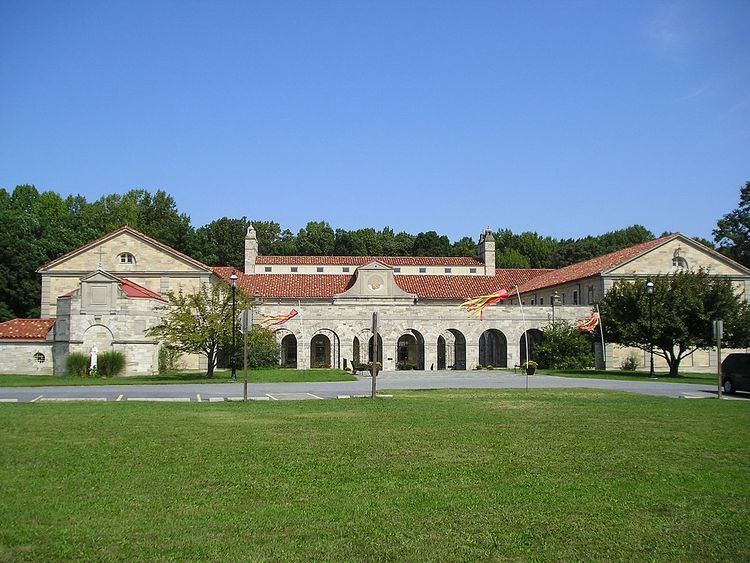Architectural type Friary/Novitate Opened 1931 Groundbreaking 1930 | Ecclesiastical or organizational status Shrine Completed 1931 Phone +1 410-531-2800 | |
 | ||
Website www.shrineofstanthony.org Address 12290 Folly Quarter Rd, Ellicott City, MD 21042, USA Architectural style Renaissance Revival architecture District Roman Catholic Archdiocese of Balti Similar Howard County Historical, Residence Inn Columbia, B&O Railroad Museum, Ellicott City B & O Railroad, Doughoregan Manor | ||
Shrine of st anthony maryland top 8 facts
The Shrine of St. Anthony is a Roman Catholic shrine honoring St. Anthony of Padua. The shrine is located within the St. Joseph Cupertino Friary in Ellicott City, Maryland, USA. The shrine is a ministry of the Conventual Franciscan Friars, Our Lady of the Angels Province, USA.
Contents
The friary covers 20,194 sq ft (1,876.1 m2) on 320 acres (1.3 km2; 0.50 sq mi) of hills and woodland.
The chapel which houses the relic of St. Anthony is open to the public during published visiting hours. Mass is offered daily throughout the year. Healing masses are offered the 3rd and last Sunday of every month. The shrine also offers the Sacrament of Reconciliation, spiritual direction, and days of prayer.
For prayer and solitude the grounds around the friary offers seven trails and a Lourdes grotto. In 2010 an outdoor shrine to St. Maximilian Kolbe was added to the garden. It features a statue of Maximilian Kolbe that was blessed by Pope John Paul II on the day Maximilian Kolbe was canonized.
The historic Manor House is open to the public during posted hours on the Sundays in October until the first Sunday of November. It features two heritage rooms and a traveling art exhibit. In 2008 it displayed watercolor paintings by Fr. Gerry Waterman, OFM Conv. and poetry by Fr. Gary Johnson, OFM Conv. The building was listed on the National Register of Historic Places in 2014.
History
The history of the property on which the Shrine of St. Anthony sits can be tied back to the Carroll family. In 1700 Charles Carroll of Annapolis was granted 10,000 acres (40 km2; 16 sq mi) of property in what is now Howard County, MD. In 1717 he began construction of Doughoregan Manor. Charles Carroll of Carrollton inherited the property and was eventually buried there. An area of 1,000 acres (4 km2) of land was sectioned off from the Doughoregan estate and given to Emily Caton MacTavish (Carroll's granddaughter) as a wedding present. The estate was immediately named "Folly Quarter". The manor house was designed by William Small, a protege of Benjamin Latrobe. It was originally built around 1730 as part of the Doughoregan Manor estate, it was then remodeled by Charles Carroll of Carrollton for his granddaughter and completed in 1832.
After Emily Caton Mactavish died on January 26, 1867 the Folly Quarter estate was sold to Charles M. Dougherty. Through inheritance and marriage the property ended up back in the hands of the Carroll family via John Lee Carroll, governor of Maryland from 1876-1880. In 1910 the property was bought by Mr. Van Lear Black, a publisher of the Baltimore Sun. In 1924 Mr. Black sold the house to Mr. Morris Schapiro, the president of the Boston Iron and Metal Company, who in turn sold the house and 236 acres (0.96 km2) of the original estate to the Franciscan Friars in 1928 for $436,000.
The Cardinal Protector of the Order, Rafael Merry del Val, Secretary of State under Pope Pius X, sent his blessing on the new establishment which was to be used by the Friars as a novitiate.
The manor house became too small for the community and one of the Friars, Fr. Benedict Przemielewski was commissioned to design a new novitate. He decided to create a miniature version of the Sacro Convento, the original Friary built in Assisi, Italy in the 13th century. Construction started in 1930 and was completed in 1931. Archbishop Michael Joseph Curley blessed the new novitate in 1931.
In 1995, the Basilica of Saint Anthony of Padua, Italy made a gift of a first class relic of St. Anthony and Reliquary to the shrine.
On July 1, 2005, William Cardinal Keeler, the Archbishop of Baltimore declared the Shrine of St. Anthony the official Archdiocesan shrine to St. Anthony.
Folly Farm
The Folly Farm house was constructed in 1730. In 1800 Charles Carroll modified the Greek, Georgian, and Romanesque building with four large front columns, a round chapel, a marble bathing pool in the cellar, and a three fireplace kitchen. Three dungeon cubes were installed with trapdoors. The house was given to granddaughter Emily Caton MacTavish to live in while Folly Quarter was under construction. The property has been subdivised to a seven-acre parcel with the house.
